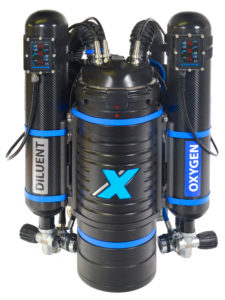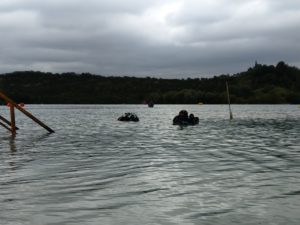Contents
Partial pressure
Partial pressure is the pressure that a component of a gas mixture will exert if it occupied the entire volume of the mixture at preserved temperature. For example, the air is a mixture of oxygen and nitrogen (for simplicity we assume that air is a mixture of only these two gases) in a ratio of 21% to 79%. On the surface, at a pressure of 1 atm, the oxygen partial pressure will be 0.21atm. At a depth of 30m (pressure of 4 atm), the partial pressure of oxygen will be 4 * 0.21 = 0.84 atm. At the same depth, the nitrogen partial pressure will be 3.16 atm.
Nitrox
Breathing mixture with an increased level of oxygen. The Nitrox is a gas with the amount of oxygen above 21%, but in practice, mixtures are found from 28% up. To begin using Nitrox gases you must complete the course Enriched Air Diver (or equivalent in other organisation). It will allow for safe dives on mixtures of up to 40% of oxygen.
TMX – Trimix
Trimix is a mixture of three gases. Usually, they are oxygen, nitrogen and noble gas (mostly helium). It is used in technical diving, at depths of below 50 meters. To start diving with trimix you need to complete the following training path: Tec40, Tec45, Tec50 (those 3 courses can be done as one TecRec training) then Tec Trimix 65 and/or Tec Trimix Diver. There are other federations which deal with the technical diving certifications and the steps look slightly different but in general, you need to learn how to deal with the decompression and how to avoid unwanted effects of the hight pressure.
MOD – Maximum Operating Depth
The maximum depth without exceeding the assumed permissible partial oxygen pressure. It should be assumed that the maximum permissible partial pressure of oxygen can not exceed 1.4at and the maximum emergency pressure can not be higher than 1.6at.
SAC – Surface Air Consumption
Gas consumption ratio based on the consumption rate on the surface. It is assumed that the average SAC for a recreational diver is 15-20l / min. Values below 15l / min prove practical knowledge of good breathing techniques. However, SAC too low (less than 10 l / min.) can cause health-threatening CO2 retention. Retention can be counteracted using the proper technique of inhaling and exhaling. Exhale should be deep – without holding back. On the other hand, a SAC of over 30l / min indicates an inexperienced diver, a respiratory difficulty, or a … an excessive amount of ballast (note: computers calculate SAC based on the pressure drop data). This means that the overloaded diver pumps his BCD with a greater amount of gas. In this case, the SAC will be much higher than the norm predicted.
CNS
CNS is an oxygen toxicity attack – oxygen intoxication (also known as the Paul Bert effect). This occurs without warning after exceeding the allowable limit of partial oxygen pressure in the breathing mixture. CNS is an acute cerebral intoxication. Oxygen toxicity is manifested by convulsions (as in the case of epilepsy). During such an attack, the diver does not control his reflexes, so most often drowning occurs after the regulator has been spitting out. CNS is accompanied by convulsions, nausea, visual and hearing impairment, dizziness, and muscle cramps.
This (rather drastic) film shows an experiment done by the US Navy in the 1940s about the sensitivity of the human body to oxygen under increased pressure.
OTU – Oxygen Tolerance Unit
Oxygenated chronic pulmonary toxicity. It is caused by a long-term (several days) oxygen exposure under increased pressure. When breathing with oxygen-enriched mixes, the amount of OTU should be monitored. One unit is an oxygen exposure with a partial pressure of 1 atm per one minute. The OTU can also be calculated with the formula:
OTU = t * [(PpO2-0.5)*2] ^ 0.83
OLF – Oxygen Limit Fraction
this parameter allows the diver to track the level of oxygen exposure during the dives (usually on enriched mixtures). It is based on two parameters CNS Toxicity and OTU – Oxygen Tolerance Unit, which is tracked by the diver’s computer. Thus, after diving, everyone knows in which range of oxygen toxicity window is located.
DCS
Decompression sickness
DCI
Decompression illness. Do not confuse DCI and DCS concepts or use them interchangeably as DCS is a subset of DCI.





